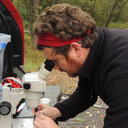Proteins specified by African Swine Fever virus. IV. Glycoproteins and phosphoproteins.
Keywords
Abstract
African Swine Fever virus infected MS cells labeled with radioactive 14C-amino acids, 32Pi or [3H]-glucosamine were examined by high resolution sodium dodecylsulfate polyacrylamide gel electrophoresis and showed 43 infected cell polypeptides. Twenty-one of these proteins were present in the nuclear fraction of infected cells. At least 22 of the infected cell polypeptides induced antibodies during natural infections in swine. The pattern of infected cell polypeptides modified by incorporation of showed prosthetic groups that at least 8 polypeptides were phosphorylated and at least three specific viral glycoproteins (A, B and C) were detected by immunoprecipitation. The most highly glycosylated polypeptide corresponds to the structural viral protein VP51.


